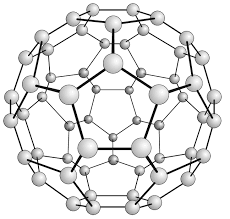نانو (باک مینستر فولرن) ؛(Buckminsterfullerene) و خصوصیات باکی بال ها (بر پایه دکترای نانو _ میکرو الکترونیک) (دکترای آموزشی _ پژوهشی )
پژوهشگر و نویسنده: دکتر ( افشین رشید)
نکته : باکی بال (C60) و فولرنها از جمله موادی هستند که بسیاری از مواد نانو بر پایه آن بنا شده است.خواص ساختاری و الکترونیکی منحصر به فرد، و نیز کاربرد آنها در زمینه های مختلف از قبیل کاربردهای الکترونیکی مانند ساخت نانو الکترود های به کار رفته در مدار های الکتریکی خاص، نانو فوتونیکی در نانو سلول های خورشیدی و جاذب نانو طول موج های خاص میباشد.
از مهمترین و منحصر به فرد ترین خواص فولرن ها، توانایی آنها در حفظ اتم ها و یا مولکول های کوچک در درون قفس کربنی می باشد. قفس های کربنی اندو هدرال (EFs) ،به دلیل پایداری ذاتی،نانو ساختارهای اندو هدرال آنها که حاوی یک یا دو اتم فلزی مانند ScوLa و یا حاوی یک فلز –نیترید خوشه ای مانندSc3N میباشند سنتز شده اند. اهمیت پارامترهای فضائی و الکترونی مرتبط با ساختار قفس مانند فولرن در عوامل این واهمیت درون گیر نانو ساختار ها و پایداری این ترکیبات میباشد. خواص نوری ، انرژی های یونش و الکترون خواهی و پایداری نسبی چند گانگی های مختلف فلرون ها بسیار تاثیر گذار در تکثیر ادوات نانو الکترونیکی میباشد.
است.قفس C60 با تقارن Ih قطری در حدود 7Å دارد. مولکول C70 نیز به شکل توپ راگبی است و تقارن آن معمولاً ساختاری مسطح دارد اما در فولرن ها آرایش 5h ،عرض آن 7Å و طول آن Å 10 است. کربن پیوندی کربن از حالت مسطح خارج می شود به طوری که سه پیوند، یک هرم کم عمق را ایجاد می کنند. فشار حاصل از این تغییر، در مولکول C60 حدود mol/kcal 400 تفاوت انرژی ایجاد می کند که این مطلب می تواند دلیل قانع کننده ای برای واکنش پذیری بیشتر فولرن ها نسبت به نانو لوله ها باشد.
سنتز و جداسازی نانو فولرن ها و باکی بال ها به روش تخلیه ی الکتریکی
این دسته از ترکیبات نانو ساختار اولین بار به روش تخلیه ی الکتریکی بدست آمدند. البته مکانیسم دقیقی برای تشکیل فولرنها شناخته نشده است، اما به نظر میرسد آنها در طی ایجاد پلاسما کربن تولید می شوند. خالص سازی فولرن ها معمولا توسط کروماتوگرافی ستونی با عملکرد بالا انجام میشود. همچنین در مقیاس کوچکتر، عمل تصعید میتواند برای تولید فولرن های عاری از حلال با خلوص بالا استفاده شود. فولرنها جامد های دوده مانند وتیره رنگ و در بعضی از موارد درخشان هستند. حلالیت فولرنها در حلالهای هیدروکربنی ناچیز است معمولا اما در حلال های نانو مولکول آروماتیک زیاد است و در ترکیبات نانو ساختار فولرنهای بزرگتر از فولرنهای کوچکتر کمتر حل میشوند.
نتیجه گیری:
باکی بال (C60) و فولرنها از جمله موادی هستند که بسیاری از مواد نانو بر پایه آن بنا شده است.خواص ساختاری و الکترونیکی منحصر به فرد، و نیز کاربرد آنها در زمینه های مختلف از قبیل کاربردهای الکترونیکی مانند ساخت نانو الکترود های به کار رفته در مدار های الکتریکی خاص، نانو فوتونیکی در نانو سلول های خورشیدی و جاذب نانو طول موج های خاص میباشد.
پژوهشگر و نویسنده: دکتر ( افشین رشید)




